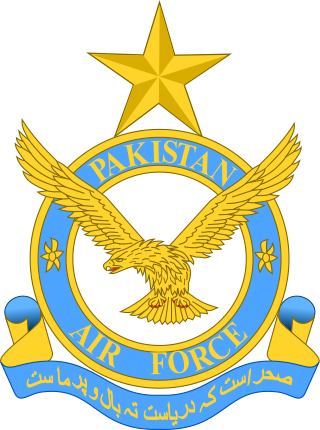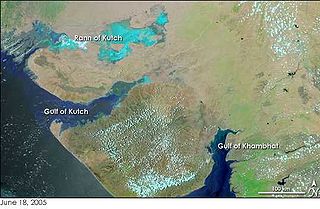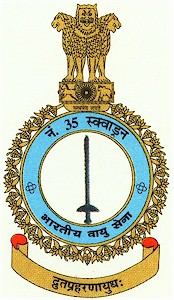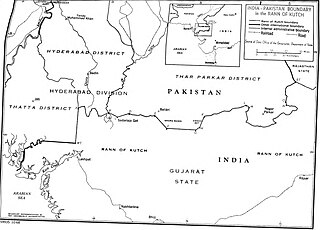
Since the Partition of British India in 1947 and subsequent creation of the dominions of India and Pakistan, the two countries have been involved in a number of wars, conflicts, and military standoffs. A long-running dispute over Kashmir and cross-border terrorism have been the predominant cause of conflict between the two states, with the exception of the Indo-Pakistani War of 1971, which occurred as a direct result of hostilities stemming from the Bangladesh Liberation War in erstwhile East Pakistan.

The Pakistan Air Force (PAF) is the aerial warfare branch of the Pakistan Armed Forces, tasked primarily with the aerial defence of Pakistan, with a secondary role of providing air support to the Pakistan Army and Pakistan Navy when required, and a tertiary role of providing strategic airlift capability to Pakistan. As of 2021, as per the International Institute for Strategic Studies, the PAF has more than 70,000 active-duty personnel and operates at least 1370+ aircraft.PAF stands as the eight largest Air Force in the world. PAF is the largest Air Force of the Muslim world in terms of aircraft fleet. Its primary mandate and mission is "to provide, in synergy with other inter-services, the most efficient, assured and cost effective aerial defence of Pakistan." Since its establishment in 1947, the PAF has been involved in various combat operations, providing aerial support to the operations and relief efforts of the Pakistani military. Under Article 243, the Constitution of Pakistan appoints the President of Pakistan as the civilian Commander-in-Chief of the Pakistan Armed Forces. The Chief of the Air Staff (CAS), by statute a four-star air officer, is appointed by the President with the consultation and confirmation needed from the Prime Minister of Pakistan.

The Indian Air Force (IAF) is the air arm of the Indian Armed Forces. Its primary mission is to secure Indian airspace and to conduct aerial warfare during armed conflicts. It was officially established on 8 October 1932 as an auxiliary air force of the British Empire which honoured India's aviation service during World War II with the prefix Royal. After India gained independence from United Kingdom in 1947, the name Royal Indian Air Force was kept and served in the name of the Dominion of India. With the transition to a republic in 1950, the prefix Royal was removed.
This is a list of aviation-related events from 1999.

The Great Rann of Kutch is a salt marsh in the Thar Desert in the Kutch District of Gujarat, India. It is about 7500 km2 in area and is reputed to be one of the largest salt deserts in the world. This area has been inhabited by the Kutchi people.

The Indo-Pakistani war of 1965, also known as the second India–Pakistan war, was an armed conflict between Pakistan and India that took place from August 1965 to September 1965. The conflict began following Pakistan's Operation Gibraltar, which was designed to infiltrate forces into Jammu and Kashmir to precipitate an insurgency against Indian rule. The seventeen-week war caused thousands of casualties on both sides and witnessed the largest engagement of armored vehicles and the largest tank battle since World War II. Hostilities between the two countries ended after a ceasefire was declared through UNSC Resolution 211 following a diplomatic intervention by the Soviet Union and the United States, and the subsequent issuance of the Tashkent Declaration. Much of the war was fought by the countries' land forces in Kashmir and along the border between India and Pakistan. This war saw the largest amassing of troops in Kashmir since the Partition of India in 1947, a number that was overshadowed only during the 2001–2002 military standoff between India and Pakistan. Most of the battles were fought by opposing infantry and armored units, with substantial backing from air forces, and naval operations.

No. 35 Squadron IAF (Rapiers) was an electronic warfare and air superiority squadron of the Indian Air Force (IAF). It was based at Bakshi Ka Talab Airforce Station, No. 35 Squadron came under the Central Air Command; and along with No. 108 Squadron formed an operational wing of the IAF. As of 2017, it was equipped with MiG-21M aircraft. The squadron was number plated in 2019.

The Sukhoi Su-30MKI is a two-seater, twinjet multirole air superiority fighter developed by Russian aircraft manufacturer Sukhoi and built under licence by India's Hindustan Aeronautics Limited (HAL) for the Indian Air Force (IAF). A variant of the Sukhoi Su-30, it is a heavy, all-weather, long-range fighter.

Operation Safed Sagar was the code name assigned to the Indian Air Force's role in acting jointly with the Indian Army during the 1999 Kargil war that was aimed at flushing out regular and irregular troops of the Pakistani Army from vacated Indian Positions in the Kargil sector along the Line of Control. It was the first large scale use of Airpower in the Jammu and Kashmir region since the Indo-Pakistani War of 1971.

Sir Creek, originally Ban Ganga, is a 96 km tidal estuary in the uninhabited marshlands of the Indus River Delta on the border between India and Pakistan. The creek flows into the Arabian Sea and separates Gujarat state in India from Sindh province in Pakistan. The long-standing India-Pakistan Sir Creek border dispute stems from the demarcation "from the mouth of Sir Creek to the top of Sir Creek, and from the top of Sir Creek eastward to a point on the line designated on the Western Terminus". From this point onward, the boundary is unambiguously fixed as defined by the Tribunal Award of 1968.
The Indian Air Force was established on 8 October 1932 independently of the army and navy and in a similar format to the British Royal Air Force. It had been a recommendation of the Skeen Committee, which had been tasked to look into demands for the Indianisation of the Indian army. Its first squadron was raised on 1 April 1933.

During the Indo-Pakistani war of 1965, the Indian and Pakistani Air Forces engaged in large-scale aerial combat for the first time. In the air war, which took place in September, both air forces conducted thousands of defensive and offensive sorties over Indian and Pakistani airspace. Both India and Pakistan claimed victory in the air war; Pakistan claimed to have destroyed 104 Indian aircraft and lost 19, and India claimed to have destroyed 73 Pakistani aircraft and lost 35 of its own. The air war ended in a stalemate.
Chir Batti, Chhir Batti or Cheer batti is a ghost light reported in the Banni grasslands, a seasonal marshy wetlands and adjoining desert of the marshy salt flats of the Rann of Kutch near the India–Pakistan border in Kutch district, Gujarat, India. Local villagers refer to the light as Chir Batti in the Kutchhi-Sindhi language, with Chir meaning ghost and Batti meaning light.
The Kutch Desert Wildlife Sanctuary is situated in the Great Rann of Kutch, Kutch district, Gujarat, India. It was declared a sanctuary in February 1986. It is the largest Wildlife Sanctuary in India regarding its size.

The Pakistan Naval Air Arm is the naval aviation branch within the Pakistan Navy that is responsible for aerial operations from the seaborne platform.
The General Dynamics F-16 Fighting Falcon has served the United States and the air arms of 25 other nations. Over 4,400 F-16s have been sold.

No. 45 Squadron Indian Air Force is a Fighter Squadron internally based at Sulur AFS, Tamil Nadu. The squadron operates the indigenous HAL Tejas fighter from 1 July 2016. The squadron was initially based at Bangalore, Karnataka and later shifted to its main base in Sulur from 1 June 2018.
On 27 February 2019, the Pakistan Air Force (PAF) conducted six airstrikes at multiple locations in Indian-administered Jammu and Kashmir (J&K). The airstrikes were part of the PAF military operation codenamed Operation Swift Retort and were conducted in retaliation to the Indian Air Force (IAF) airstrike in Balakot just a day before on 26 February.
Squadron Leader Prashant Kumar Bundela was a fighter pilot of the Indian Air Force who shot down Pakistan Navy Atlantic over the Rann of Kutch soon after the 1999 Kargil War. He received the prestigious Vayusena medal for this operation on 26 January 2000. He died in 2002 in a MiG-21 crash.

Operation Desert Hawk was the codename of a military operation planned and executed by the Pakistan Army in the Rann of Kutch area, the disputed area which was under Indian control from the long-standing status quo. The boundary of Rann of Kutch was one of the few un-demarcated boundaries pending since the 1947 partition of India.
















